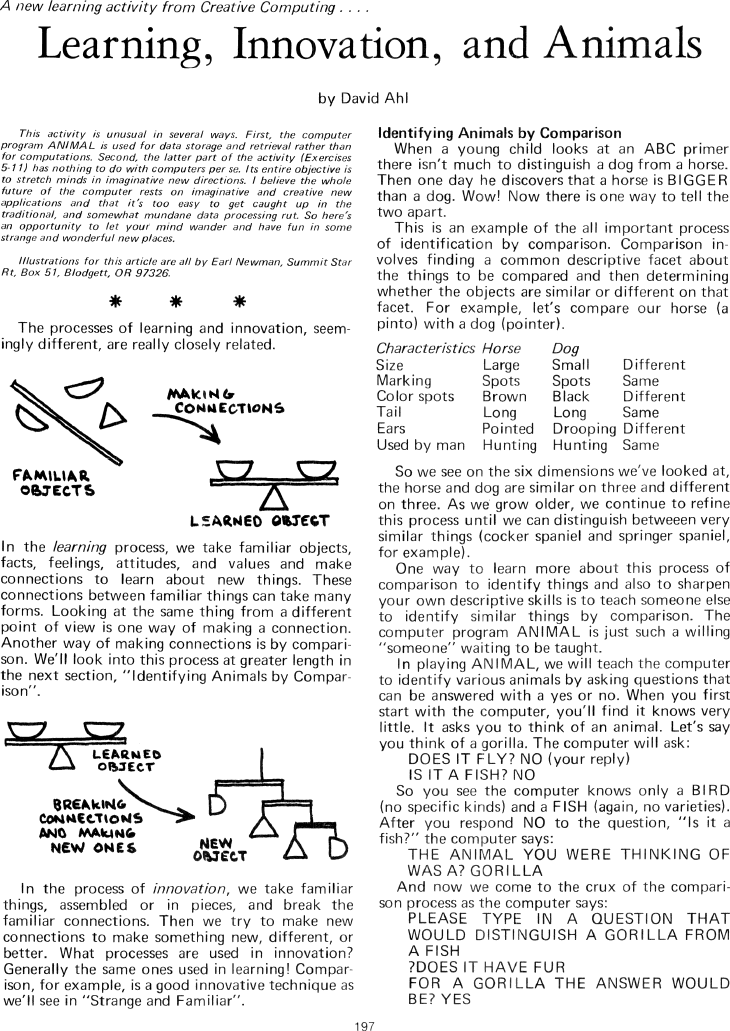The Best of Creative Computing Volume 1 (published 1976)
Learning, Innovation, and Animals (ANIMAL computer program for learning, identifying animals by comparison)

A new learning activity from Creative Computing....
Learning, Innovation, and Animals
by David Ahl
This activity is unusual in several ways. First, the computer program ANIMAL is
used for data storage and retrieval rather than for computations. Second, the
latter part of the activity (Exercises 5-11) has nothing to do with computers
per se. Its entire objective is to stretch minds in imaginative new directions.
I believe the whole future of the computer rests on imaginative and creative new
applications and that it's too easy to get caught up in the traditional, and
somewhat mundane data processing rut. So here's an opportunity to let your mind
wander and have fun in some strange and wonderful new places.
Illustrations for this article are all by Earl Newman, Summit Star Rt, Box 51,
Blodgett, OR 97326.
***
The processes of learning and innovation, seemingly different, are really
closely related.
[image]
MAKING CONNECTIONS
FAMILIAR OBJECTS
LSARNED OBJECT
[image]
In the learning process, we take familiar objects, facts, feelings, attitudes,
and values and make connections to learn about new things. These connections
between familiar things can take many forms. Looking at the same thing from a
different point of view is one way of making a connection. Another way of making
connections is by comparison. We'll look into this process at greater length in
the next section, "Identifying Animals by Comparison".
[image]
LEARNED OBJECT
BREAKING CONNECTIONS AND MAKING NEW ONES
NEW OBJECT
[image]
In the process of innovation, we take familiar things, assembled or in pieces,
and break the familiar connections. Then we try to make new connections to make
something new, different, or better. What processes are used in innovation?
Generally the same ones used in learning! Comparison, for example, is a good
innovative technique as we'll see in "Strange and Familiar".
Identifying Animals by Comparison
When a young child looks at an ABC primer there isn't much to distinguish a dog
from a horse. Then one day he discovers that a horse is BIGGER than a dog. Wow!
Now there is one way to tell the two apart.
This is an example of the all important process of identification by comparison.
Comparison involves finding a common descriptive facet about the things to be
compared and then determining whether the objects are similar or different on
that facet. For example, let's compare our horse (a pinto) with a dog (pointer).
Characteristics Horse Dog
Size Large Small Different
Marking Spots Spots Same
Color spots Brown Black Different
Tail Long Long Same
Ears Pointed Drooping Different
Used by man Hunting Hunting Same
So we see on the six dimensions we've looked at, the horse and dog are similar
on three and different on three. As we grow older, we continue to refine this
process until we can distinguish betweeen very similar things (cocker spaniel
and springer spaniel, for example).
One way to learn more about this process of comparison to identify things and
also to sharpen your own descriptive skills is to teach someone else to identify
similar things by comparison. The computer program ANIMAL is just such a willing
"someone" waiting to be taught.
In playing ANIMAL, we will teach the computer to identify various animals by
asking questions that can be answered with a yes or no. When you first start
with the computer, you'll find it knows very little. It asks you to think of an
animal. Let's say you think of a gorilla. The computer will ask:
DOES IT FLY? NO (your reply)
IS IT A FISH? NO
So you see the computer knows only a BIRD (no specific kinds) and a FISH (again,
no varieties). After you respond NO to the question, "Is it a fish?" the
computer says:
THE ANIMAL YOU WERE THINKING OF WAS A? GORILLA
And now we come to the crux of the comparison process as the computer says:
PLEASE TYPE IN A QUESTION THAT WOULD DISTINGUISH A GORILLA FROM A FISH
?DOES IT HAVE FUR
FOR A GORILLA THE ANSWER WOULD BE? YES


